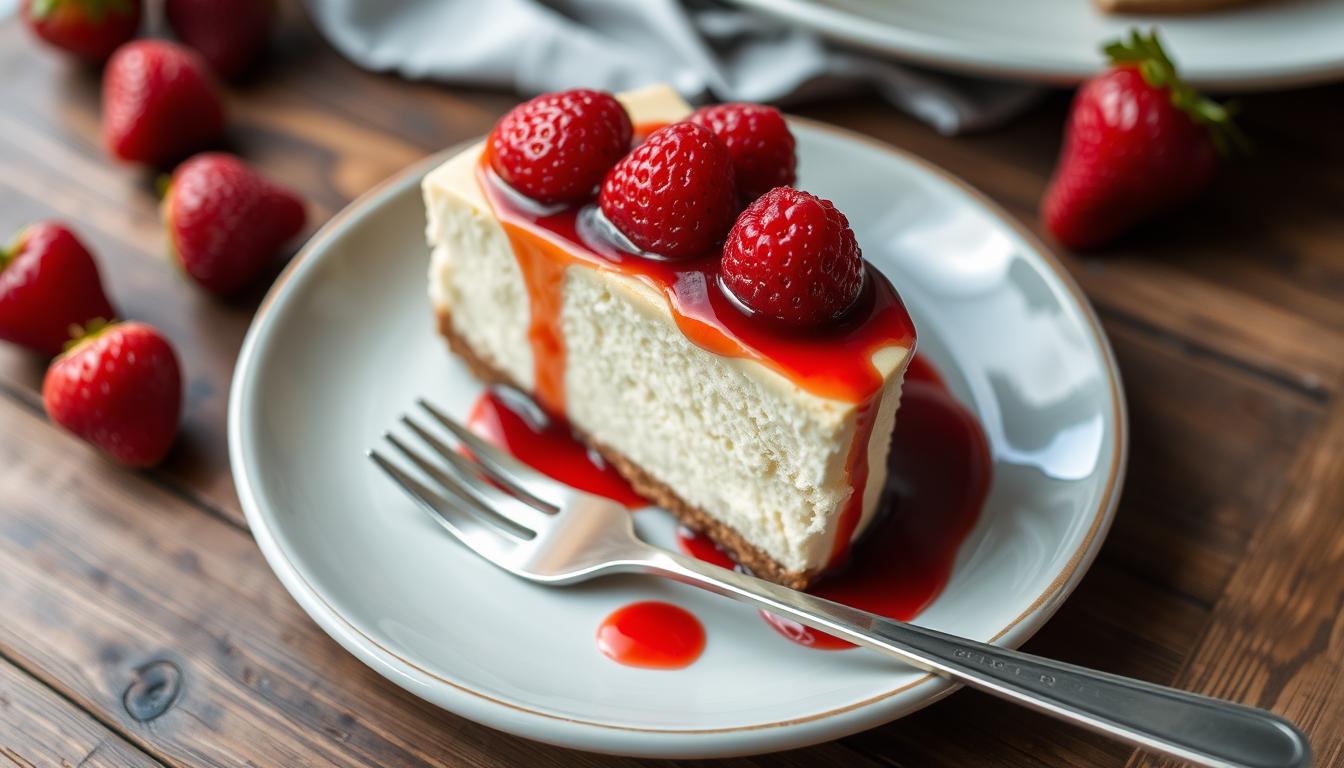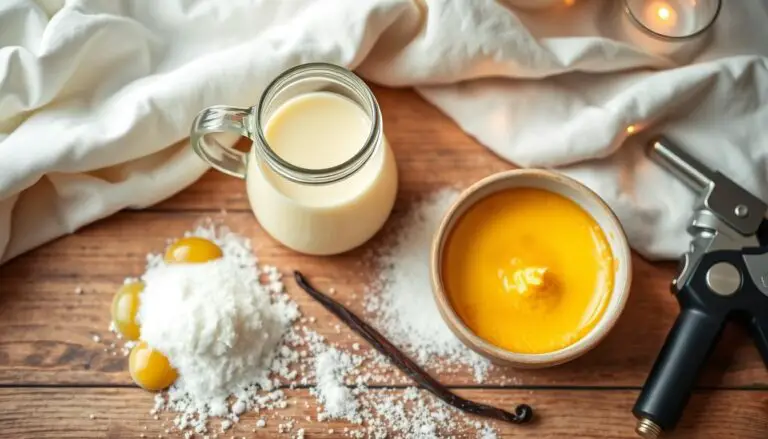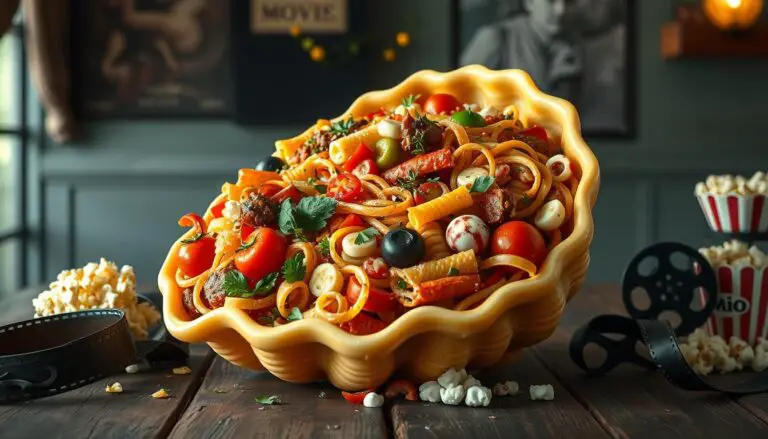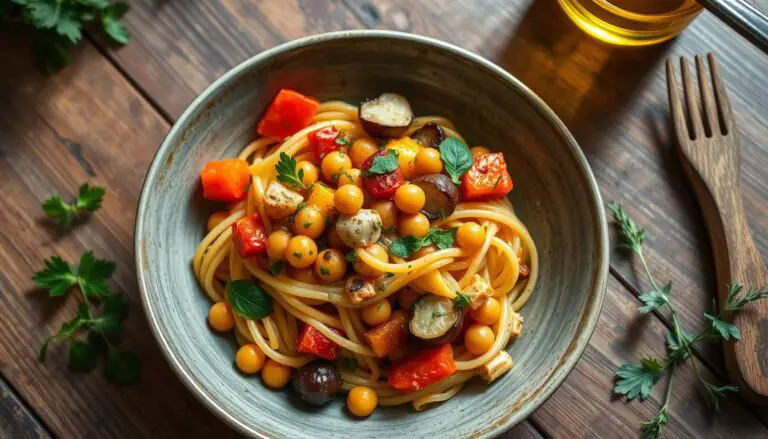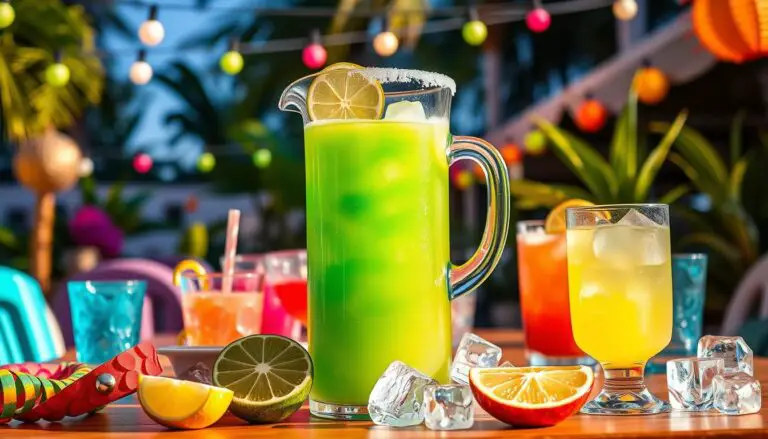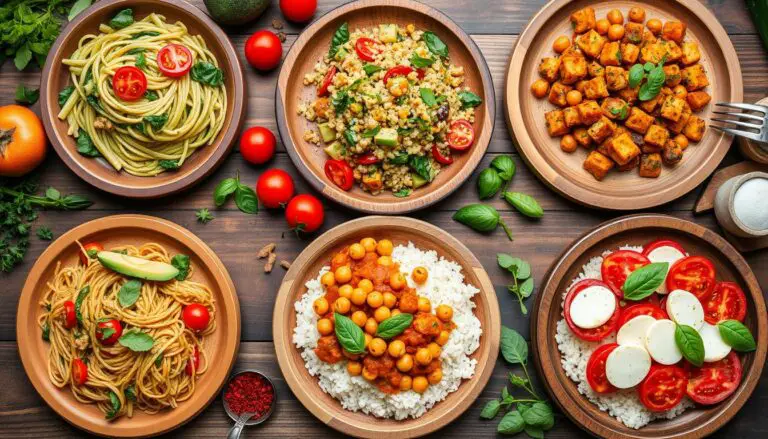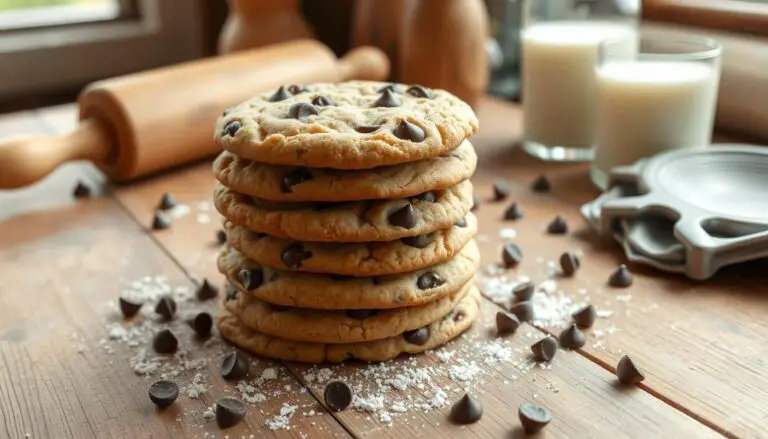Philadelphia Cheesecake Recipe: Creamy Perfection
Philadelphia cheesecake is a classic dessert that stands out for its rich taste. It’s famous for its creamy texture, making it a favorite in the US. It’s perfect for any event, adding sweetness and a smooth feel that everyone loves.
The secret to its amazing taste is Kraft Philadelphia cream cheese. It adds real richness to each bite. In this article, we’ll show you how to make this beloved dessert easily and confidently.
Key Takeaways
- Philadelphia cheesecake is known for its rich, creamy texture.
- This classic dessert is perfect for various occasions.
- Kraft Philadelphia cream cheese enhances the flavor.
- Understanding the recipe will help achieve a perfect cheesecake.
- This dessert can be customized with various toppings and flavors.
Introduction to Philadelphia Cheesecake
The story of Philadelphia cheesecake is rich in flavor and tradition. It started in the United States and has become a favorite. The cheesecake’s roots go back to ancient Greece, but the version we love today began in Philadelphia in the late 19th century.
Philadelphia cream cheese is at the heart of this dessert. It makes the cheesecake creamy and smooth. This ingredient gives the cheesecake its famous richness. Over time, bakers have made many variations, pleasing different tastes.
The history of cheesecake is more than just flavors. It shows a cultural importance that many share. Philadelphia cheesecake is loved at gatherings and is a favorite in homes and restaurants. Its ability to please dessert lovers makes it a classic choice for any event.
| Year | Milestone |
|---|---|
| 1800s | Introduction of cream cheese in Philadelphia. |
| 1920s | Increased popularity as a dessert in homes and restaurants. |
| 1980s | Rise of various cheesecake flavors and styles. |
| Present | Continued celebration of Philadelphia cheesecake at events and gatherings. |
Key Ingredients for a Perfect Cheesecake
To make a delicious cream cheese cheesecake, knowing the key ingredients is crucial. The right mix of ingredients can greatly affect the taste and texture. Let’s explore the essential parts that will make your cheesecake special.
Choosing the Right Cream Cheese
Quality cream cheese is essential. Using top-notch dairy, like Kraft Philadelphia cream cheese, ensures a consistent taste and texture. This brand is known for its smoothness, making it perfect for cheesecakes.
The creamy texture of this cream cheese mixes well with other ingredients. It adds to the cheesecake’s velvety flavor, pleasing everyone who tries it.
Importance of Fresh Ingredients
The freshness of your ingredients is key to a great cheesecake. Use fresh eggs, sugar, and pure vanilla extract. These ingredients improve the taste and texture, making the cheesecake rich and creamy.
Fresh ingredients make the cheesecake taste better, making each bite unforgettable. Choosing these elements ensures your cheesecake turns out perfectly.
Philadelphia Cheesecake Recipe: Step-by-Step Instructions
Making a classic philadelphia cheesecake recipe takes careful steps. First, preheat your oven to 325°F (163°C). This ensures it’s ready for baking.
Begin with the crust. Here’s what you need:
- 1 ¾ cups graham cracker crumbs
- ½ cup unsalted butter, melted
- ¼ cup sugar
Mix the crumbs, sugar, and melted butter in a bowl. Press it into a 9-inch springform pan. Bake for 10 minutes until it’s golden. Let it cool.
Now, make the cheesecake filling. You’ll need:
- 24 ounces cream cheese, softened
- 1 cup sugar
- 3 large eggs
- 1 teaspoon vanilla extract
- 1 cup sour cream
Beat the cream cheese until it’s smooth. Add sugar and mix well. Add eggs one at a time, blending each time. Mix in vanilla and sour cream for a creamy texture.
Pour the filling over the cooled crust. Smooth the top. Bake for 55-60 minutes. It should wobble a bit but not be runny. Let it cool in the pan before removing the sides.
Chill the cheesecake in the fridge for at least four hours. Overnight is even better. This step enhances the creamy texture and flavor.
Follow these steps to make this delicious dessert. Making the perfect Philadelphia cheesecake requires precision and patience.
Graham Cracker Crust: The Essential Base
The graham cracker crust is key to a classic Philadelphia cheesecake. It’s made from crushed graham crackers, butter, and sugar. This mix creates a perfect balance of taste and texture. Making an easy graham cracker crust will make your cheesecake stand out.
How to Make a Graham Cracker Crust
Making an easy graham cracker crust is simple. First, gather these ingredients:
- 1 ½ cups of crushed graham crackers
- ½ cup of unsalted butter, melted
- ¼ cup of granulated sugar
Put the crushed graham crackers, melted butter, and sugar in a bowl. Mix until it looks like wet sand. Press it into a greased 9-inch springform pan. Bake at 350°F for 10 minutes or until it’s set. This crust is crisp and flavorful, perfect for the cheesecake filling.
Alternative Crust Options
Want to try something different? Consider a chocolate crust or nut crusts. A chocolate cookie crust adds a rich taste. Nut crusts, like almonds or walnuts, are gluten-free and offer a unique texture.
Trying different crusts can change how your cheesecake tastes and feels. Check out this resource for more cheesecake tips. Or learn about graham cracker crusts at this site.
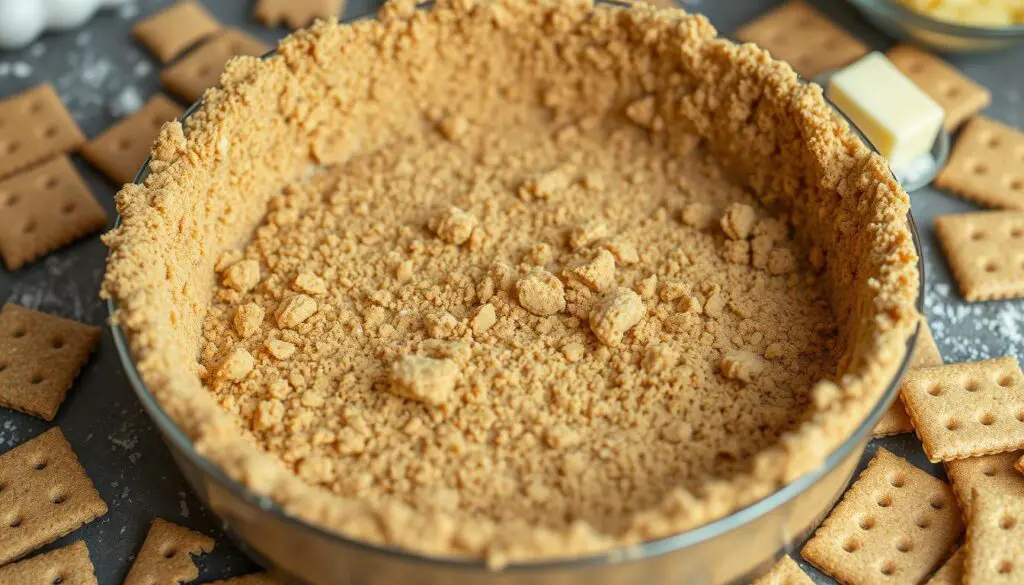
Understanding Cheesecake Baking Techniques
Baking cheesecake right is key to avoiding mistakes. It’s all about mastering techniques like water bath baking. Knowing these tricks helps make your cheesecake both tasty and beautiful.
Avoiding Common Mistakes
Getting a perfect cheesecake needs focus. Here are some common errors and how to avoid them:
- Overmixing the batter can introduce too much air, leading to cracks.
- Using ingredients directly from the fridge may cause uneven baking.
- Not allowing the cheesecake to cool gradually can result in unsightly cracks.
- Skipping the water bath method increases the risk of overcooking.
By following these tips, you’ll make a cheesecake that’s always a hit.
Water Bath Baking for Even Cooking
The water bath is crucial for even baking. It keeps the temperature steady, stopping the edges from cooking too fast. Here’s how to do it right:
- Wrap the bottom of the cheesecake pan in aluminum foil to prevent leaks.
- Place the pan inside a larger baking dish.
- Fill the outer pan with hot water, ensuring it reaches halfway up the sides of the inner pan.
- Bake as instructed, monitoring the water level throughout the process.
This method greatly lowers the risk of cracks and sinking. It makes your cheesecake smooth and perfect.
| Mistake | Consequence | Preventative Tip |
|---|---|---|
| Overmixing | Cracks | Mix on low speed just until combined |
| Chilling too fast | Texture issues | Gradually cool in the oven with the door ajar |
| Skipping the water bath | Uneven baking | Always use a water bath for dense cheesecakes |
Achieving a Smooth Cheesecake Texture
Getting a smooth cheesecake texture is more than just using the right ingredients. It’s about the mixing techniques and cooling methods. A well-mixed cheesecake tastes better and feels creamier, making it a joy to eat.
Mixing Techniques for Creaminess
The secret to a smooth cheesecake is in the mixing. Start with top-notch ingredients. Use an electric mixer to blend the batter evenly. Mix at low speed first, then increase it to avoid lumps.
This method stops overmixing, which can cause air pockets and cracks. It’s crucial for a smooth texture.
- Use room temperature cream cheese for easier blending.
- Incorporate eggs one at a time to maintain a smooth texture.
- Gently fold in any additional flavors or ingredients to prevent deflating the batter.
Cooling and Chilling Tips
After baking, the cheesecake needs careful cooling. Follow these tips to avoid cracks. Let it cool slowly in the oven with the door ajar. This helps prevent texture changes.
For chilling, put it in the fridge for at least 4 hours, or better yet, overnight. Keep it at 40°F to set it right without losing its creaminess.
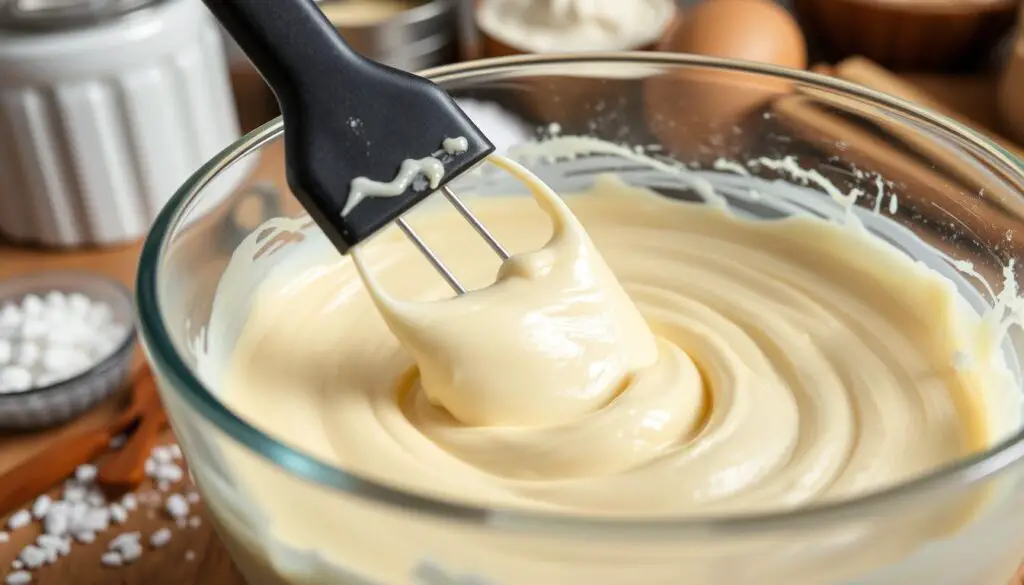
| Cooling Method | Advantages | Best Practices |
|---|---|---|
| Room Temperature Cooling | Prevents cracks caused by sudden temperature changes | Cool in the oven with the door ajar for 1 hour |
| Chilling in the Refrigerator | Enhances texture and flavor | Chill for a minimum of 4 hours, ideally overnight |
Flavor Variations and Additions
Cheesecake offers endless ways to add flavor. You can top it with various toppings or mix in different flavors. This makes every cheesecake unique and special.
Classic Toppings for Your Cheesecake
Classic toppings can make your cheesecake even better. Here are some favorites:
- Fresh berries – strawberries, blueberries, or raspberries are great on cheesecake.
- Chocolate sauce – a chocolate drizzle is perfect for chocolate lovers.
- Whipped cream – adds a creamy texture to every bite.
- Caramel drizzle – adds sweetness and a nice contrast.
Try seasonal or themed toppings for a unique twist. For fall, add crushed pumpkin spice cookies or apple slices with cinnamon.
Adding Fruit and Flavors to the Batter
To mix up your cheesecake, add fruit purees or extracts to the batter. Mango, lemon, or passion fruit can make it vibrant. Just adjust the sweetness to keep it balanced.
Exploring different flavors is exciting. You can add:
- Fruit purees – blend ripe fruits for a refreshing twist.
- Extracts – vanilla, almond, or espresso add depth.
- Cocoa powder – for a chocolatey dream cheesecake.
Remember, balance is key to keep your cheesecake creamy and tasty. For more ideas, check out this flavored cheesecake recipe.
New York Style Cheesecake vs. Philadelphia Cheesecake
The debate between New York style and Philadelphia cheesecakes excites dessert lovers. Both have rich flavors but differ in style. Knowing these differences helps us enjoy each cheesecake more.
New York style cheesecake is known for its dense, creamy texture. It uses more cream cheese and eggs for a custardy feel. Sour cream or heavy cream adds to its luxurious taste. This cheesecake is simple, letting the cream cheese be the star.
Philadelphia cheesecake, however, is lighter. It mixes less cream cheese with whipped cream for a silkier texture. Its subtle sweetness is appealing, making it great for those who like a sweet but not too sweet dessert. Adding vanilla or lemon zest makes it even fresher.
| Characteristic | New York Style Cheesecake | Philadelphia Cheesecake |
|---|---|---|
| Texture | Dense and creamy | Lighter and silkier |
| Main Ingredients | High cream cheese, eggs, sour cream/heavy cream | Balanced blend of cream cheese and whipped cream |
| Flavor Profile | Rich and custardy | Sweet yet refreshing |
| Cultural Origin | New York, USA | Philadelphia, USA |
In summary, comparing cheesecakes shows a delightful contrast. Each style has its own charm, appealing to different tastes. They are both favorites in the baking world.
Cheesecake Baking Tips for Perfection
Every cheesecake baker knows the secret to success is understanding temperatures. Getting the right cheesecake baking temperature is key. It’s important to consider the proper temperature for both preparation and baking. This leads to the perfect cheesecake texture.
The Importance of Temperature
Start with ingredients at room temperature, especially cream cheese. Cold cream cheese can cause lumps. Make sure the oven is preheated to the right temperature for even cooking. This ensures a rich, creamy texture and helps avoid cracks.
How to Check for Doneness
To check if the cheesecake is done, look for visual cues and texture. The center should have a slight jiggle, but the edges should be firm. The toothpick test is also reliable. If it comes out clean or with a few moist crumbs, it’s ready.
Below is a table summarizing the recommended cheesecake baking temperatures and the corresponding signs that indicate doneness:
| Cheesecake Type | Recommended Baking Temperature (°F) | Signs Cheesecake is Done |
|---|---|---|
| Classic Cheesecake | 325 | Slight jiggle in the center |
| New York Style Cheesecake | 350 | Edges firm, center slightly soft |
| No-Bake Cheesecake | Not Applicable | Chilled until set completely |
Serving and Storing Your Cheesecake
After baking and chilling your cheesecake, serving it right can make a big difference. Start by letting it warm up to room temperature for 30 minutes. This makes cutting easier. Use a knife that’s been in hot water and then dried to get clean cuts.
For a nice touch, top each slice with fresh fruit, chocolate, or whipped cream. This not only looks good but also tastes great.
Best Practices for Serving
Think about the atmosphere when you serve your cheesecake. Place the slices on a fancy platter and add small forks or spoons. This makes it easy for guests to enjoy. You can also label the toppings to encourage people to try new things.
Whether it’s a classic New York style or a creamy Philadelphia one, the right presentation will impress everyone.
How to Store Leftovers Properly
Storing cheesecake properly is key to keeping it fresh. If you have leftovers, wrap them tightly in plastic or foil and refrigerate. This keeps them good for up to five days.
For longer storage, freeze the cheesecake. Wrap each slice in plastic, then put them in a sealed container. This way, you can enjoy cheesecake weeks later without losing its quality.

